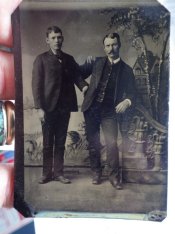summicron1
Subscriber
No, I don't mean the pictures themselves are ugly. I'm referring to the technical condition.
Consider this thing making its way around the interweb -- a series of tintypes shot of movie stars at this year's Sundance Film Festival:
http://www.esquire.com/blogs/cultur...lture/sundance-tintype-portraits-2014#slide-1
They're pretty, sure, or at least interesting, but what strikes me is how many of them -- if not all -- have serious blemishes -- smears, scratches, blots, uneven areas, and on and on.
In my humble collection of photographic junque I've accumulated a lot of old tintypes -- the sort made in the 1860s and later. These were cranked out in small town studios by photographers using 1860s technology, equipment and darkrooms. Cripes, they didn't even have electricity. God only knows what unknown chemicals were in their water or how pure their chemistry was.
And yet -- their tintypes are flawless, or at least a lot better than the ones I see in this collection. The areas around the edge may have a few issues, but I wonder how much of that is age and how much of it the photographer allowed, knowing the gold frame of the little pressed-paper box would hide it anyway.
Typical sample:
So, here's my question: Are folks making tintypes with these flaws intentionally, so they have a "look" of old tintypes that the viewing public apparently expects, even though real old tintypes look a lot better? I've seen even National Geographic running special photo series of tintypes of events that included many images with flaws that were pretty large.
Or are they still just learning the process and have not, by dint of repetition, yet achieved the level of skill necessary to produce clean tintypes? I know making tintypes is not easy -- I've only tried it once -- but that's kind of the point. The more you do it, the better you get. Perhaps people doing these things need to work at it more?
The reason this bothers me is that I work in a local museum and have an opportunity to look at a lot of old pictures. Those old photographers were real craftsmen, their work was first rate, even the guys working out of store fronts in podunk towns like Ogden, Utah.
People doing "old process" photography who produce images full of these sort of flaws are making the general public think that that's what photography was like back then, and isn't it nice that photography now is so much better?
But it's not. It's vastly different, but not better. Those old technicians knew their stuff. Their best images will survive the centuries with anything shot today.
The real trick is to produce good images, both technically and visually. If you have to hope that "looking old" or being funky and fuzzy is what makes the image attractive, it's time to go back and work some more.
Consider this thing making its way around the interweb -- a series of tintypes shot of movie stars at this year's Sundance Film Festival:
http://www.esquire.com/blogs/cultur...lture/sundance-tintype-portraits-2014#slide-1
They're pretty, sure, or at least interesting, but what strikes me is how many of them -- if not all -- have serious blemishes -- smears, scratches, blots, uneven areas, and on and on.
In my humble collection of photographic junque I've accumulated a lot of old tintypes -- the sort made in the 1860s and later. These were cranked out in small town studios by photographers using 1860s technology, equipment and darkrooms. Cripes, they didn't even have electricity. God only knows what unknown chemicals were in their water or how pure their chemistry was.
And yet -- their tintypes are flawless, or at least a lot better than the ones I see in this collection. The areas around the edge may have a few issues, but I wonder how much of that is age and how much of it the photographer allowed, knowing the gold frame of the little pressed-paper box would hide it anyway.
Typical sample:

So, here's my question: Are folks making tintypes with these flaws intentionally, so they have a "look" of old tintypes that the viewing public apparently expects, even though real old tintypes look a lot better? I've seen even National Geographic running special photo series of tintypes of events that included many images with flaws that were pretty large.
Or are they still just learning the process and have not, by dint of repetition, yet achieved the level of skill necessary to produce clean tintypes? I know making tintypes is not easy -- I've only tried it once -- but that's kind of the point. The more you do it, the better you get. Perhaps people doing these things need to work at it more?
The reason this bothers me is that I work in a local museum and have an opportunity to look at a lot of old pictures. Those old photographers were real craftsmen, their work was first rate, even the guys working out of store fronts in podunk towns like Ogden, Utah.
People doing "old process" photography who produce images full of these sort of flaws are making the general public think that that's what photography was like back then, and isn't it nice that photography now is so much better?
But it's not. It's vastly different, but not better. Those old technicians knew their stuff. Their best images will survive the centuries with anything shot today.
The real trick is to produce good images, both technically and visually. If you have to hope that "looking old" or being funky and fuzzy is what makes the image attractive, it's time to go back and work some more.












